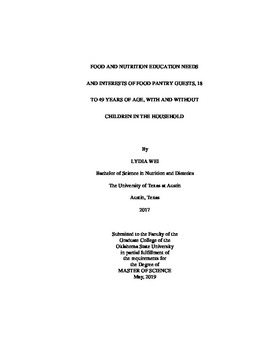| dc.description.abstract | Payne Country has the second highest food insecurity rate in Oklahoma. This study surveyed food pantry guests, 18 to 49 years of age, with and without children in the home at Our Daily Bread Food and Resource Center about food security, pantry views, demographics, food and health indicators and food and nutrition education interests. One hundred and fourteen participants completed the survey with 56 having children in the home and 58 not having children in the home. Most were White, but a higher percentage were Native American and African American compared to Payne County's racial breakdown. The majority were female, had a high school education, were unemployed and had an annual income below $12,000. Food assistance programs mostly utilized were food pantries and SNAP. Only 4.4% of the participants reported they were college students. Most had low fruit, vegetable and dairy consumption. Participants reported seldom or only some days consuming breakfast, lunch and snacks and having food to create healthy meals. Only 19.5% reported they were interested in food and nutrition education classes, but 45.1% were possibly interested. Education interests included "healthy eating at home," "meal planning," "adult nutrition," and "stretching your food dollar." There were significant differences in participants' interest in classes on "childhood nutrition" and "teen nutrition" and "classes for children in the family," with more participants with children being interested compared to those without children. Barriers to attending education were work, transportation, children and childcare. Most participants perceived themselves as having good, very good or excellent health. Few participants reported chronic disease conditions except for high blood pressure. Half were classified as obese, a fourth were classified as overweight while another fourth were classified as normal weight. Over half had anxiety and depression and a fourth had fatigue. Lack of social support appeared to be problematic. Most were comfortable with food-related activities. The combination of weight status, poor diet, lack of social support and emotional stress may increase participants' risk of future chronic disease. Beyond interest in child and family educational topics, there were few differences between those with and without children. | |
